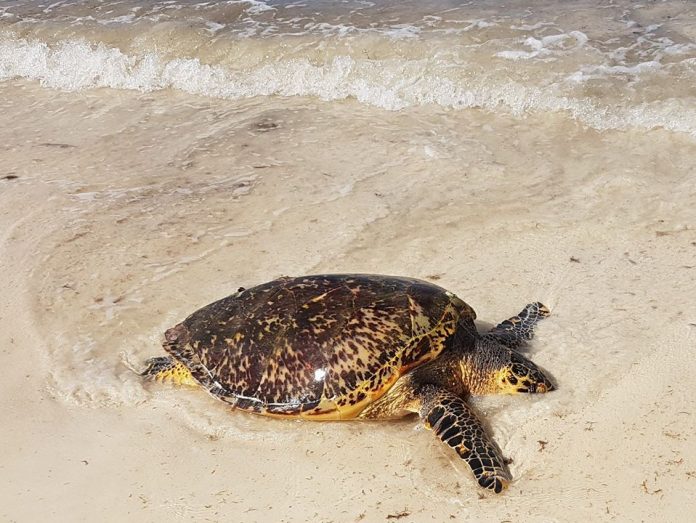While we humans are currently at home in this COVID-19 period, the sea turtles continue to follow their natural routine. There are five Leatherback (Driekiel) nests on the west coast of our island already, four at the Eagle Beach / Low Rise Hotels area and one on Palm Beach.
In recent years we rarely saw a turtle nest on Palm Beach, but this used to be an important nesting area. In the 1990s and early 2000s, Turtugaruba, (the Aruban foundation for the conservation of sea turtles) has led many Leatherback hatchlings (baby turtles) to the sea on that beach. Under the current circumstances of a quiet beach and less light at night, it is possible that the adult Leatherbacks will return to laying eggs on Palm Beach this season.
Leatherback sea turtles that nest in Aruba do not live in the Caribbean Sea, but in the North of the Atlantic Ocean and were born on the Aruban beach. When a Leatherback female is mature (after 20 – 30 years) she returns to her native beach to lay eggs during the nesting season (March to July). A Leatherback lays an average of seven nests per season. After the last clutch she leaves again for the cold waters of the Atlantic Ocean where she will stay for two or three years before returning for another season.
Leatherbacks and all sea turtle species are endangered species worldwide and need our protection. Like every year, nests from 2020 are marked with DOW’s well-known red and white barricades. The nest can hatch after 60 to 70 days of incubation. At the moment our beaches are quiet, but what will the situation be like in two months? Full of people and more light at night?
Artificial light and sea turtles do not go well together. The adult sea turtles feel frightened by artificial light, causing them to not come up the beach far enough to find a good nesting place. If a sea turtle is disturbed during multiple nesting attempts, she might even give up and drop the eggs into the sea. That nest then is lost.
When a nest hatches in the night after two months, the little hatchlings are attracted to artificial light, and they will not reach the sea on their own due to disorientation. What to do to protect the sea turtles? With Shelter In Place’s rules in place during the day and Curfew at night, people are unlikely to find a sea turtle on the beach. However, while walking on a beach during the day for one’s own physical health, sea turtle tracks or a nest may be observed.
Please notify Turtugaruba immediately: Turtle Hotline 24/7 (+297 5929393).
And a special request to the people who have to go out at night (such as Police and Security) to continue respecting the following points. When you see a sea turtle that comes / is ashore to nest:
- Contact Turtugaruba immediately (Turtle Hotline +297 5929393)
- Do not approach the sea turtle, but keep a distance (at least 15 meters).
- Do not use any kind of light, such as a flashlight, flash camera or phone screen. Turn off all lights in the area and never direct light towards a sea turtle.
- Limit movement and noise around the sea turtle to prevent distraction.
- Make sure that the sea turtle can return to the sea undisturbed after nesting, do not stand between the sea turtle and the sea. The total nesting process takes an average of 2 hours.
For more information, please contact Turtugaruba:
TURTLE-HOTLINE: + 297 5929393 E-mail: turtugaruba@hotmail.com Facebook.

















